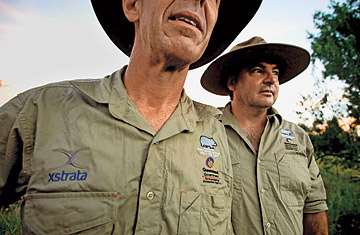
Wildlife officials sport corporate and critter logos.
It's a steamy antipodean evening, and I'm lost in the Australian bush, wandering around a remote patch of Queensland that is the last redoubt of one of the world's rarest large mammals: the northern hairy-nosed wombat. Only 115 of the burrowing, nocturnal marsupials survive in this 7,800-acre (3,160 hectare) preserve at Epping Forest National Park, and I've ventured out in the hope of spotting one. As my footsteps send wallabies bounding through the scrub, something shuffles through the grass a few yards ahead. I aim my flashlight, and I'm startled to find myself confronting a small, bearlike wombat. I've just become one of only a few hundred people who have ever been face to face with the northern hairy-nose, because none are in captivity.
So how do you snatch from extinction's grasp a critter so reclusive it's an afterthought for government funding when compared with A-list animals like the panda? Answer: Do what sports teams have done with their stadiums. Brand the wombat with a corporate logo.
In a world first, Xstrata, a $28 billion Swiss global mining company, has agreed to fund an endangered species' recovery. In exchange for spending millions on the marsupial, Xstrata's name will appear on everything wombat: from websites to educational DVDs to shirts worn by wildlife workers. Xstrata execs will also star in documentaries about the northern hairy-nose and speak at media events. Call it the ultimate in green corporate branding.
The Xstrata money is paying for the creation of a second wombat colony some 435 miles (700 km) to the south, and later this year wildlife officials plan to relocate some wombats to seed a new population as an insurance policy against a catastrophic fire or other calamity at Epping.
To keep the wombat from going the way of the dodo, environmental officials gathered at Epping in late 2007 to brainstorm a radical shift in strategy: they would abandon business as usual by embracing Big Business. The wombat program had operated on a shoestring budget for years, and millions were needed to establish the second colony. "To do this properly, we need the big bucks," said Queensland wildlife-conservation chief Rebecca Williams, sitting at a table outside the ramshackle trailer that serves as the camp's kitchen and makeshift lab. "So think differently."
Also at the table was Wes Mannion, head of Australia Zoo, the for-profit founded by the late Steve Irwin, the "Crocodile Hunter." The zoo had inked a deal with the government to help save the wombat, mainly through research support. "It's all about the marketing and money, mate," chimed in Mannion, an Irwin look-alike in his Aussie safari outfit. That view won over Alan Horsup, a conservation officer who spent the past two decades in an often lonely quest to pull the northern hairy-nose back from the edge of extinction. "I didn't like it at first," he said of corporate sponsorship. "But bloody hell, why can't we have the BHP wombat?"
That would be BHP Billiton, mate, an Xstrata rival. In fact, Geoff Clare, an executive director of Queensland's Environmental Protection Agency, had mining in mind because the industry had raked in record profits thanks to Australia's commodity boom. Some green sheen wouldn't hurt the industry one bit.
